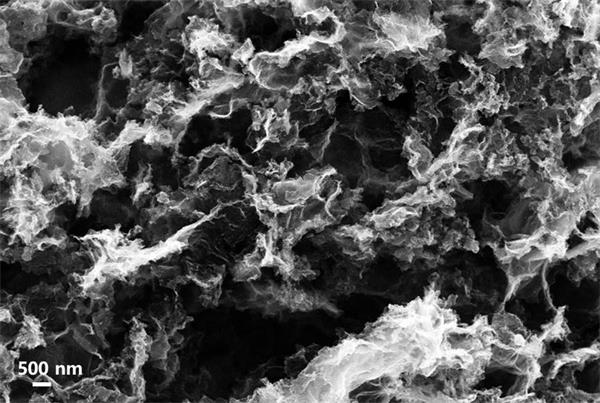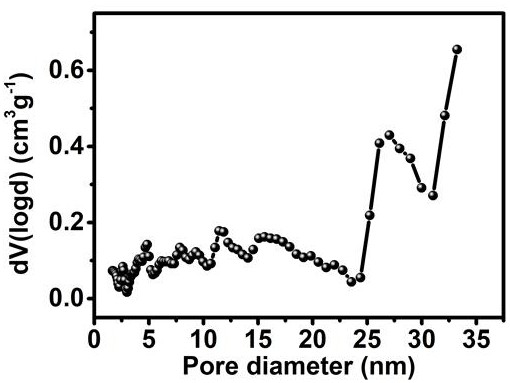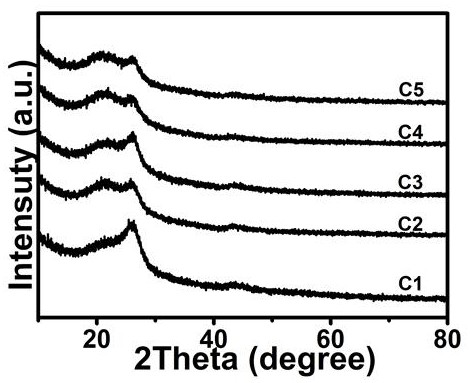Preparation method of Fe3C nanoparticle-loaded porous nitrogen-doped graphene oxygen reduction catalyst
A nitrogen-doped graphene and nanoparticle technology, applied in structural parts, electrical components, battery electrodes, etc., can solve the problems of weak tolerance, high cost, low reserves, etc., to increase active sites, improve oxygen Reducing catalytic activity and improving ORR activity
- Summary
- Abstract
- Description
- Claims
- Application Information
AI Technical Summary
Problems solved by technology
Method used
Image
Examples
Embodiment 1
[0026] Step S1: Disperse 1g of graphene oxide into 100mL of deionized water, disperse 0.5g of porphyrin iron into 50mL of N,N-dimethylformamide (DMF), ultrasonicate for 10min, mix quickly, and stir at room temperature for 24h , centrifuged, and the centrifuged product was dried in an oven at 80°C for 24 hours to obtain material A1;
[0027] Step S2: Transfer material A1 to a nickel boat and place it in a tube furnace. 2 In the atmosphere, the temperature was raised to 700°C at a heating rate of 10°C / min and kept for 180 minutes, and then the temperature was naturally cooled to room temperature to obtain material B1;
[0028] Step S3: Transfer the material B1 to a container and add a hydrofluoric acid solution with a mass concentration of 15wt% to soak for 24 hours, then wash the filtrate with high-purity water until it becomes neutral, and then dry it in a blast oven at 80°C for 6 hours to obtain the target product C1.
Embodiment 2
[0030] Step S1: mix 1g graphene oxide and 0.5g SiO 2 Disperse in 100mL of deionized water, disperse 0.5g of porphyrin iron into 50mL of DMF, sonicate for 10min, mix quickly, stir at room temperature for 24h, centrifuge, and dry the centrifuged product in an oven at 80°C for 24h to obtain material A2;
[0031] Step S2: Transfer the material A2 to a nickel boat and place it in a tube furnace. 2 In the atmosphere, the temperature was raised to 700°C at a heating rate of 10°C / min and kept for 180 minutes, and then naturally cooled to room temperature to obtain material B2;
[0032] Step S3: Transfer the material B2 to a container and add a hydrofluoric acid solution with a mass concentration of 15wt% to soak for 24 hours, then wash the filtrate with high-purity water until it becomes neutral, and then dry it in a blast oven at 80°C for 6 hours to obtain the target product C2.
Embodiment 3
[0034] Step S1: mix 1g graphene oxide and 1g SiO 2 Disperse in 100mL of deionized water, disperse 0.5g of porphyrin iron into 50mL of DMF, sonicate for 10min, mix quickly, stir at room temperature for 24h, centrifuge, and dry the centrifuged product in an oven at 80°C for 24h to obtain material A3;
[0035] Step S2: Transfer material A3 to a nickel boat and place it in a tube furnace. 2 In the atmosphere, the temperature was raised to 700°C at a heating rate of 10°C / min and kept for 180 minutes, and then naturally cooled to room temperature to obtain material B3;
[0036] Step S3: Transfer the material B3 to a container and add a hydrofluoric acid solution with a mass concentration of 15 wt% to soak for 24 hours, then wash the filtrate with high-purity water until it becomes neutral, and then dry it in a blast oven at 80°C for 6 hours to obtain the target product C3.
PUM
 Login to View More
Login to View More Abstract
Description
Claims
Application Information
 Login to View More
Login to View More - R&D
- Intellectual Property
- Life Sciences
- Materials
- Tech Scout
- Unparalleled Data Quality
- Higher Quality Content
- 60% Fewer Hallucinations
Browse by: Latest US Patents, China's latest patents, Technical Efficacy Thesaurus, Application Domain, Technology Topic, Popular Technical Reports.
© 2025 PatSnap. All rights reserved.Legal|Privacy policy|Modern Slavery Act Transparency Statement|Sitemap|About US| Contact US: help@patsnap.com



